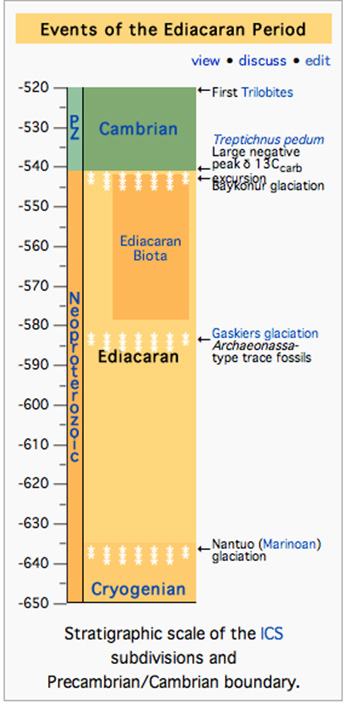

The Ediacaran Period named after the Ediacara Hills of South Australia, is the last geological period of the Neoproterozoic Era and of the Proterozoic Eon, immediately preceding the Cambrian Period, the first period of the Paleozoic Era and of the Phanerozoic Eon.
The Ediacaran Period's status as an official geological period was ratified in 2004 by the International Union of Geological Sciences (IUGS), making it the first new geological period declared in 120 years. Although the Period takes its name from the Ediacara Hills where geologist Reg Sprigg first discovered fossils of the eponymous biota in 1946, the type section is located in the bed of the Enorama Creek within Brachina Gorge in the Flinders Ranges of South Australia. Read more ...
Fossils on the Edge of Forever PhysOrg - December 14, 2009
Astrobiologists have not yet found alien life on other planets. But the fossil record has evidence of aliens of another sort: the Ediacarans that lived on Earth millions of years ago. This year marks two important anniversaries in the history of the study of life on Earth: the birth in 1919 of the geologist Reginald Sprigg, and the death in 1989 of the paleontologist Martin Glaessner. Both of these men spent large portions of their careers working on some of the most enigmatic creatures in the fossil record - the Ediacarans - a group of multicellular organisms that lived for a relatively narrow slice of time between 575 and 542 million years ago during the Ediacaran period (whose span was formally defined in 2004 as encompassing the interval between 635 and 542 million years ago).
The fleeting existence of the Ediacaran biota occurred just before the rise of complex animal life. In the years immediately following the end of the Second World War, Sprigg was prospecting for uranium to feed BritainŐs nascent atomic bomb program. He searched the hills of the Flinders Range some five hundred miles north of Adelaide, Australia. The low-angled sunlight threw the surrounding rocks into stark relief, and Sprigg noticed some peculiar dimples and indentations in the rock. Further work revealed that they were impressions of strange soft bodied organisms, and that the rock could be dated unequivocally as Precambrian. It was an astonishing discovery because it proved that the deep time fossil record that Darwin had been so anxious to find did, after all, exist.
Fractal patterns of early life revealed -- New Scientist - July 17, 2004
Newly uncovered fossils reveal in extraordinary clarity the strangeness of the Earth's earliest complex life. The finds show that the organisms were assembled in fractal patterns from frond-like building blocks. They were unable to move and had no reproductive organs, perhaps reproducing by dropping off new fronds.
The creatures, which were neither animals or plants, are called "rangeomorphs". They first appeared on the ocean floor 575 million years ago, after the last global glaciation, and were among the first of the soft-bodied creatures in the Ediacaran period. This biota survived until 542 million years ago, when modern animals diversified rapidly in the Cambrian explosion and most Ediacaran species vanished.
Until now, almost all Ediacaran fossils were squashed flat, and the few that were not were poorly preserved. This led to debate over whether the poor preservation obscured links to later life, or if the Ediacaran organisms were in fact a failed experiment in evolution that simply became extinct. The newly unearthed fossils, from Newfoundland, Canada, were preserved three-dimensionally in fine-grained mud by a "one-in-a-million" streak of luck, says Guy Narbonne of Queen's University in Kingston, Ontario. Just after a mud flow entombed the organisms, a nearby volcano erupted, covering it with a thick ash protective ash deposit. Later, the bed escaped the strain that altered most of the rock in the region. Now weathering is exposing them so they basically pop out of the rock.
That exceptional preservation is cracking the mystery of Ediacara. In some spots the surface has eroded and we see for the first time what was inside an Ediacaran fossil. Each frond element, a few centimetres long, was made of many tubes held up by a semi-rigid organic skeleton. The frond elements had branches which themselves had branches, a classic fractal structure. Frondlets assembled themselves like building blocks to make larger living structures attached to the sea floor. Narbonne found rangeomorphs assembled in several different shapes, which he believes filtered food from different levels of the water column, as well as isolated free-living frondlets.
The fractal patterns look complex, but Narbonne says their self-similarity means that very simple genomes - expected in early organisms - would suffice both to assemble individual frondlets and to control their assembly into larger structures. That would explain why the rangeomorphs evolved first. They accounted for over 80% of fossils early in the Ediacara period, when there were no mobile animals or traces of burrows. But they declined as more mobile animals evolved, apparently unable to compete, or perhaps being eaten themselves.
Geological time gets a new period BBC - May 17, 2004
The Ediacaran begins at the end of the last ice age of the Snowball Earth, or Cryogenian Period, a term given to a series of glaciations that covered most of our planet between 850-630 or 600 million years ago. One theory proposes that these climate shocks triggered the evolution of complex, multi-celled life. Geologists have added a new period to their official calendar Earth's history - the first in 120 years. The Ediacaran Period covers some 50 million years of ancient time on our planet from 600 million years ago to about 542 million years ago. It officially becomes part of the Neoproterozoic, when multi-celled life forms started to take hold on Earth. However, Russian geologists are unhappy their own title - the Vendian - which was coined in 1952, was not chosen. The decision was taken after a fifteen-year long period of consideration by expert geologists.
ANCIENT AND LOST CIVILIZATIONS